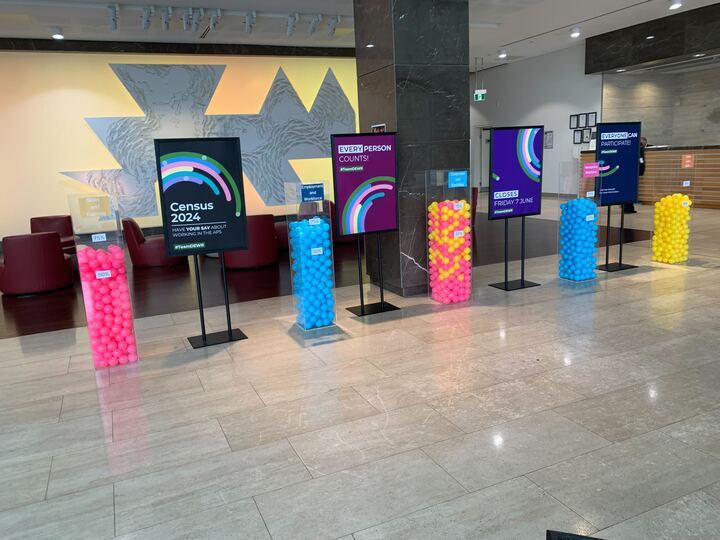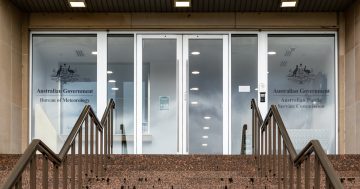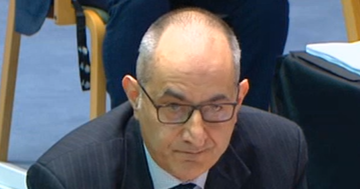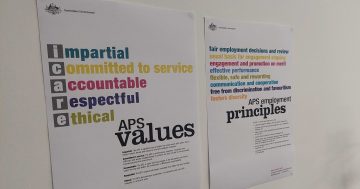
It’s a race to see which DEWR group has the best APS Employee Census participation. Photo: James Day.
Today, Friday, 7 June, is the day the APS Employee Census 2024 closes.
It has been open for a month since 6 May, with ‘invitations’ issued over the first five days of what is described as the survey administration period.
The word ‘invitation’ is interesting in this context because it makes census participation sound like some form of exclusive and coveted opportunity.
The fact is, the Australian Public Service really wants all its employees to take part.
Not everyone does, of course. It’s a voluntary census.
(The Department of Parliamentary Services doesn’t take part at all, preferring to run its own survey.)
But in the last couple of years, there has been increased persuasion to entice the workforce to engage with it.
Every department has an ‘Agency Census Coordinator’ whose role is ensuring everyone understands the process and to lure as many as possible to join in on the fun.
Over this current census period, however, the level of encouragement appears to have surged somewhat.
In fact, it’s starting to sound like the census isn’t all that voluntary after all.
There is an increasing amount of pressure being exerted on staff to take part.
Employees across the service are being bombarded with internal messages urging them to complete the census before it’s too late.
Team leaders have been charged with making sure their underlings have had the survey front-of-mind the entire month it’s been open.
Internal comms teams are creatively flogging the census big time.
More interesting (bizarre even) is that agency bosses have turned the employee census into an internal competition.
Let’s take the Department of Employment and Workplace Relations, for example.
As employees walk in and out of the department’s Canberra headquarters at 50 Marcus Clarke Street each morning, lunchtime, tea break and evening, they are greeted with the highest form of pressure advertising one could encounter.
Right in the main foyer are five clear glass silos filled to various and growing levels with coloured balls representing what percentage of staff have submitted a completed census survey.
They can be seen from the path outside – they’re that big, colourful and in your face.
The glass pillars represent the four groups within the department, each headed by a deputy secretary, plus the commissioner-led Jobs and Skills Commission.
They are Skills and Training, Employment and Workforce, Corporate and Enabling, Workplace Relations, and Jobs and Skills.
Each glass receptacle is labelled with a group’s name, and the race is on to see which one fills up first.
From the picture above, it looks like it has been very much a close race – if looks can be believed.
Next to the glass boxes and their coloured balls, scream heavy marketing posters urging census participation and reminding everyone of the closing date.
There’s a competition within DEWR to see which group of employees can make their bosses look the best.
It’s not just DEWR, of course. Every agency has been pushing census participation in its own big ways.
But that’s what the census has become – a popularity contest.
The Senior Executive Service knows that the more people who fill out the census, the higher the chances are of them getting a good review.
Sure, there is a risk that feedback might not all be favourable, but the higher risk is being seen to lead an agency of disengaged staff.
And the Australian Public Service Commission is happy to join in with some push-polling.
On its census information for employees, the Commission gives a clear indication of what the government is really looking for.
Here’s a snippet.
“Did you know that last year’s census found:
- 78% of employees agreed their job gave them opportunities to utilise their skills
- 92% of employees understand how their role contributes to achieving an outcome for the Australian public
- 90% of employees were happy to go the ‘extra mile’ at work when required, and
- 84% of employees believe strongly in the purpose and objectives of the APS.”
Those are great stats! Any boss would be thrilled to have them recorded by their staff. But it clearly reads like that’s what the SES is expecting (steering) from this year’s census.
“While everyone is encouraged to have their say, participation in the census is entirely voluntary,” the APSC census team’s document reads.
“However, the more people who respond, the more representative and useful the results will be.”
With agencies now required to publish census results and action plans resulting from the data, these persuasion methods are likely to keep ramping up year after year.
It begs the question of how indicative results will be if the APS Employee Census continues morphing into an SES-run competition and one with an increasingly passive-aggressive approach to encouraging participation.


















